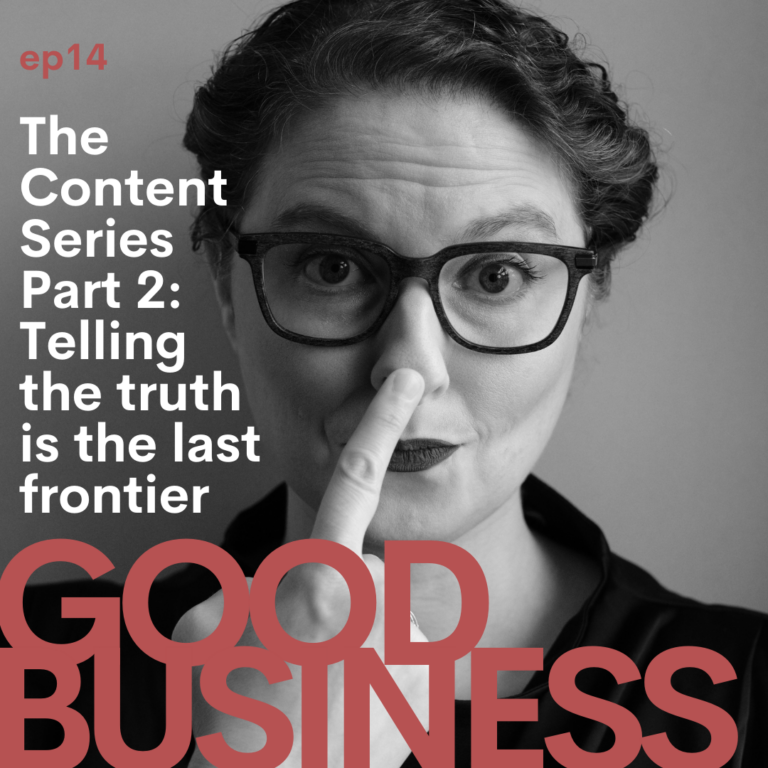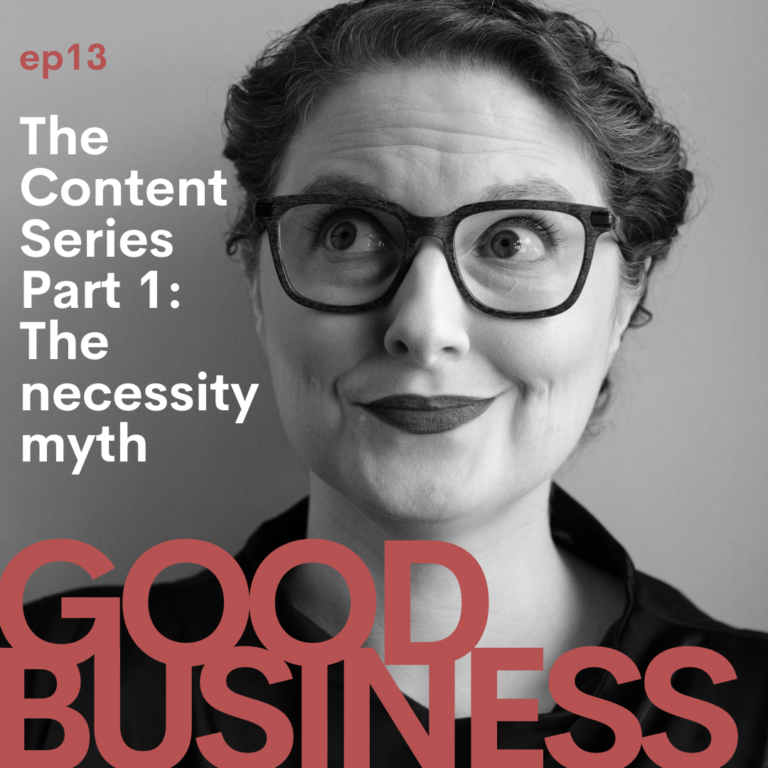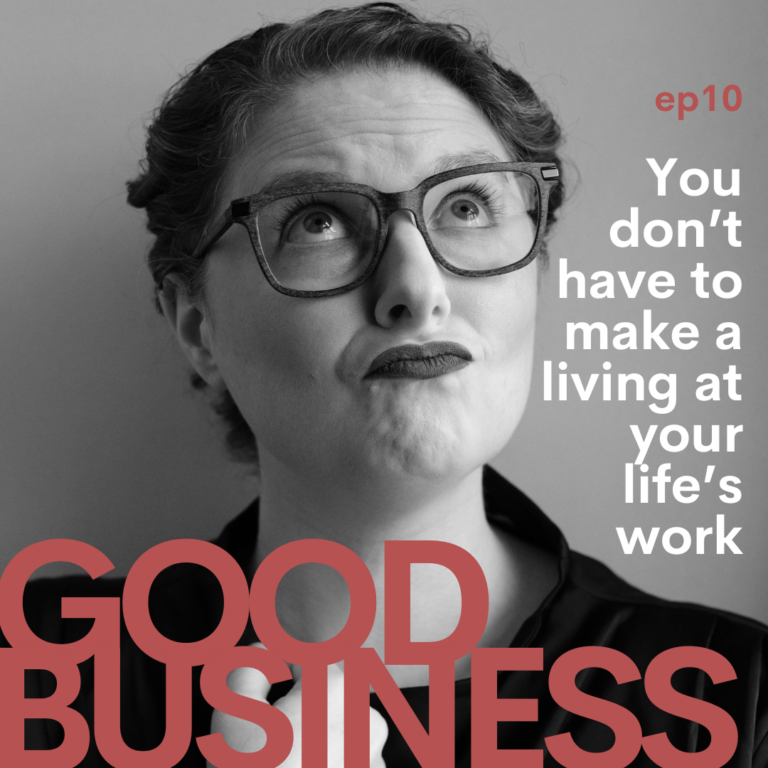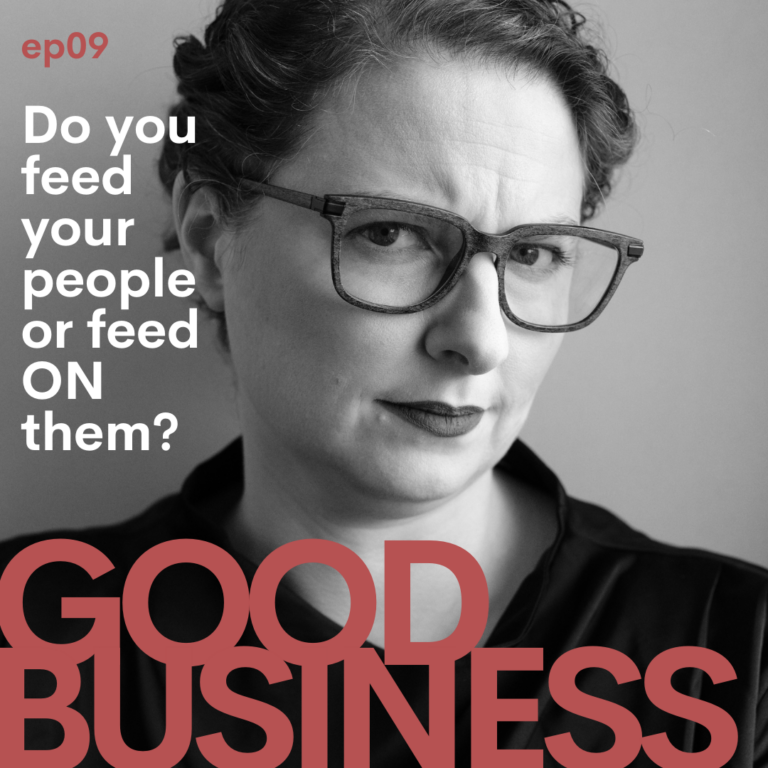Episode Transcript:
I’m Illana Burk, CEO of Your Life’s Workshop, coach to entrepreneurs and solopreneurs across dozens of industries and host of Good Business. With nearly 20 years experience helping hundreds of clients create profitable, ethically driven and sustainable businesses based on their life’s work, I’m here to teach you how to do great work, make great money, and make a positive impact without feeling like you need a shower afterwards.
Welcome, everybody. Today’s episode is about the fine art of designing offers and revenue models that work for your work because when it comes to how you deliver what you do, one size most definitely does not fit all. I was on a call with a client a few days ago — a little backstory on this. The client and I have been working together for years. I have watched and been a part of her business growth for a long time. When we began, she had a brick and mortar business. That was the sort of thing that has a standardized business model; she doesn’t have a lot of choices about how she markets her stuff because it’s such a heavy competition area. There are parameters. There’s insurance, and there are external things that she has to grapple with, that limit her choices of like what she can do with it and how she can offer it.
It’s a standardized service with pretty standardized pricing. The only things that were within her control were how she marketed her services. She came to me to do that work. The marketing part of, how can I make more money, and how can I grow this? She also knew that she wanted more freedom from the form that she was stuck in. She wanted to be able to travel. She wanted to be able to do deeper, less standardized work than the cultural and societal expectations around the profession she chosen, that would allow. She really enjoyed her work, but it was more of the results that she enjoyed than the actual work itself. She was in a healing modality. This gives you a little more context.
Fast forward, back to the call. We’re threeish years later. We’re back to this call a few days ago, and over that time she had built a brand that set her on that path. It took her a really long time, longer than either of us planned. Over that time, we nurtured both for brick and mortar business and her newer endeavor, which was an online-only model. We created opportunities for both brands, and they both grew bit by bit, and we both grew over that time, too. I learned more, and she learned more – which is probably a topic for a whole other episode because when you share your work in your lives with people, it’s a big thing, so we’ll definitely prepare that talk another time – but here’s what happens. When you learn over time, you come up with new ideas.
You get clearer and clearer and clearer over time. The more time you spend, the more data you have, the more opportunities present themselves. We always struggled, though, to find service offerings that were an all the way fit that ticked all of her boxes. She needed to maintain her brick and mortar business while growing her online one. This is fucking hard as shit. We all know that if you’re somebody who has a side hustle, let alone having two separate businesses that feed each other but are separate. This is not an easy thing. Over the past six months, her capacity started to change. She started going through some personal evolution. She pursued a new methodology that had called to her.
That methodology turned out to be a cool bridge between the two spaces. Now I’m getting back to the call from last week. I said I was doing that and then I have wandered off again. Sorry. Back to the call. As a result of all this evolution, all this process, all this reevaluation, all this learning, and all this digging in, we came to a whole new concept. It checked all of those boxes, all the ones that we set out to achieve all those years ago, even when she didn’t even fully know what she wanted. It was more like she knew how she wanted to feel.
Here’s how that played out. She started offering a class in this new methodology that I mentioned, and she filled the first class. From there, she started hearing from those clients and students that they wanted more ways to practice at home. They wanted more independence. They wanted to be able to connect with the work she was doing more, which was progressively at the same time lighting her up more than any of her other work was, and she saw results from people that were profound. She started to see beyond a profession or a modality, to a real purpose in life. Then it started to feel like something even bigger. Her people also really wanted a way to connect more and deepen their sense of community around this new work. What we came up with was a structure for a membership site. The framework would directly respond to her client’s needs and desires, to connect more, and to have a way in which they can easily access a way to practice at home.
It was another way of stabilizing her income in between class cycles. It allowed her freedom and flexibility to do whatever she wanted. To grow, to change, to learn, and to not be tied to a brick and mortar business. It could easily start to replace her brick and mortar income if it was marketed well. We all know that membership sites have the capacity for major growth because the sky’s the limit on how many people you bring in, which brings us to the last point of almost unlimited scalability. She was going to size out of her brick and mortar business. There’s only so many times slots, and there’s only so much capacity for growth. Scalability was going to progressively become more difficult if she wanted to grow and make more money, and have a bigger impact, et cetera.
Our mutual enthusiasm when we came up with this was electric. It started as a little kernel of, “Hey, maybe you should start a group.” Then it became, “Hey, maybe you should charge for that group thing. Oh, and then you could do this, and you could have videos, and you could add in this. And there’s all this incredible software out there now that does that. And Holy Shit.” As we’re talking on her coaching call, this concept started to evolve and unfold and we realized how effortless it was, how easy it felt, how aligned it felt for everything she wanted and everything I wanted for her as her coach partner, and it reinvigorated her enthusiasm for her overall work and mission in the world, immediately. That alignment reinvigorated mine.
Here are the three lessons I want to highlight here in this conversation. Your business model is like everything. You’ll never feel successful until you find and create a model that works for your business and your life in equal measure. There’s no other option. If you want to be a solopreneur and you feel the way you spend your time and energy should be about something more than making a living, which if you’re listening, you feel that way. No one listens to my podcast if they don’t feel that way. That means your business model and your service offerings are so much more important. Getting that right is so much more important.
You’ve heard me talk about things like delivering on your promises and coming at your service offerings from that standpoint. This is a piece of that bigger conversation. You’ve got to work backward from where you want to end up, instead of going, “Oh, I’m a life coach, so I’ll do three months of biweekly coaching, and it’ll cost $1,600. because that’s what everybody does and that’s what it should be.” You have to be able to look differently at your work.
The second thing in finding the right one is something that aligns with everything you want and with the people you want to serve. That can take a really, really long time because you need the information to know what those things are. You need data, and you need patterns, and you need to know what all the different components are. It’s not something that you’re going to get correct right out the gate. It just isn’t. So uncovering that model requires a ton of vigorous learning and it requires help. Somebody like me, a business community, something. It requires you to push yourself to learn and grow past what you previously understood as your capacity or desire for learning. You have to suck it up and do it.
One of the common mistakes see people make when they embark on new work is they fail to fully grasp the ripple effect of their chosen field. In many fields, there are limits. Whether you want to admit that or not. If you want to be a massage therapist, you’re limited by your time and physical ability. Some people will be able to do a little more, but some people will be able to do a little bit less. There’s not a person on earth that can do more than six to eight massages in a day. That’s crazy. So you’ve got to know that, you have to do the math on that. How much money can you make doing that? What if you really filled every slot, what’s the highest level of capacity that you could reach doing that? How long can you do it? You are constrained by the physical parameters of life. You’re not going to be able to do that forever physically. You’re probably not going to want to do that forever. So in every industry, in every field, there are actual logistical limits.
Now, of course, you can be the next dollar shave club and upset an industry and do things completely differently and change the capacity and change the rules. But how many of those are there? When you’re thinking about doing something like, I want to be a healer, or I want to be a coach, or I want to open a store, there’s going to be some boundaries that you probably should at least respect. You’re probably not the beautiful, glowing unicorn of massage therapy that can somehow figure out how to upend an industry and find more capacity. Some things have limits, and it’s okay to respect those limits because what you can do once you know those limits, is give you the sandbox you know you’re playing in.
It means instead of asking yourself what work will make you happy you should be asking yourself, what action makes you happy in general? Maybe it’s not the work. Maybe it’s how you want to live your life, how you want to feel, or how you want to experience the world. What are the logistics that will make you happier? Are you dying to live in a beach house on the coast somewhere? Do you crave living out of your car? I don’t know. What’s the actual lifestyle that feels like it calls to you?
You have to be able to align your work and the capacity of your work with the lifestyle that you want, or you’re never going to get it. You have to make sure those things happen in tandem. First, you ask yourself, what makes you happy in general? What’s the lifestyle that you want to achieve?
I’m going to pause there for a second. That’s why lifestyle brands work because fundamentally, we are all chasing a lifestyle underneath. Even when it’s about business coaching, the reason why business coaches post pictures of themselves in exotic locations is that we want the lifestyle of their success. We tend to pay attention a little bit less to the content if they have a lifestyle we want. That’s why that works. If you’ve ever wondered why that works, that’s why. Your subconscious cares more about that than it does about the content. You have to think about that, recognize that I’m shining a light on something people don’t shine a light on. If you do this deliberately, then you don’t end up falling prey to those Id taking over moments where you’d sign up for courses that are way too expensive, and they take you nowhere because you’re feeding that person’s lifestyle, you’re not learning what it takes to be a person who has that lifestyle.
So first you’re going to ask yourself, what makes you happy in general? Then you’re going to ask yourself what type of impact do you want to have on others? Not what kind of work you want to do. To go back to my client, she’s a natural healer. She wants to heal people. That’s what’s underneath it all. There are a million ways to do that, and if you focus on the impact that you want to have on people, you might find yourself exploring work and modalities and options that you never thought you would. That’s when you come from, “what do you want the result to be?” rather than, “I want to help people or I want to change the world, or I want to have an impact.” What kind of an impact? What kind of change? How do you want to affect people specifically?
For me, I like making people’s dreams come true. That’s my cheesy big why. That’s the impact I want to have. I want to make as many people have the thing that makes them happy and makes their livelihood work as possible before I die. For whatever reason, that’s the way I’m wired.
The second step is, you ask yourself what type of impact you want to have on others. Then you look for a work life that can hold both of those things in equal measure. Then you think about, “okay, what kind of lifestyle might that look like if I want to have that kind of impact? Can I do that in four hours a day? Or am I somebody who wants to do this morning, noon and night?” There is no right answer to that but look for something that can align all of that and can check all the boxes, at least from a capacity standpoint.
The business model comes later. We’re talking about the work right now. We’re talking about the actual logistics of how I’m going to be a healer. It’s more of an industry, I guess. Then there’s going to be lots of permutations within the industry of how you deliver on that. It requires more than market research, although and market research is part of it. That’s not demographics and understanding if there’s a market for your product, it’s understanding the market itself, understanding what works and what doesn’t, what society will allow and what it doesn’t, within that modality or chosen industry. It requires capacity research in yourself and society, such as, where are the boundaries, where are the edges of the sandbox that you can plan.
It requires you to understand all the edges of what your chosen work is, and whether there are chains that you can live with or whether you’ll have to break them and reinvent them. You might find that if you play this out in your head all the way, and do all this homework before you’ve moved forward on anything, you might find that you’re not willing to do that work. If it requires you to reinvent a whole industry so that you can be happy within it, maybe it’s time to look at a different industry. Maybe it’s time to look at something different altogether. You have to be humble enough to know that and to pay attention to it. That’s how a lot of people end up in industries that they don’t want to be in because they don’t understand all these components up front and they don’t do this work.
So as you grow into how you offer your work, the model that you choose should take all of these things into consideration. First, some examples to give you some logistics because I know that this is a heady topic. If you desperately want to feel the power of community, you want people to know that there are villages that will hold them, your mission in life is to make sure people feel less alone and feel like community is possible for them, then setting up a one-on-one coaching model is probably not going to do that because there’s only so many times you can tell people to join an Improv class. That’s one example.
Another example would be, if you see yourself as a location independent professional, a storefront will probably feel like shackles. If you want to make a big impact on a lot of people while also being able to work a few hours a week, you can’t possibly expect a high ticket price or high touch experience to work right out of the gate. You don’t have the credibility for it. If you want to have a broad impact, having a high ticket price is going to limit the number of people that can participate. You have to play these things out.
The formula is desired impact plus personal fulfillment plus known market constraints, equals a business model that can work for you. Essentially, start where you want to end up and work backward from there. My MBA is in sustainable enterprise, and one of the concepts we always worked with is backcasting. If you’re interested, look it up. Do some googling. It’s really fascinating. It’s a way of solving some of the world’s biggest problems, starting from the solution and working backward from the solution to find all the steps on the pathway to get there.
You can totally do that. Figure out what you want your life and your work to look and feel like, and then you work backward from there. That’s how you create a business that is not only financially successful but one that can make you happy, one that you’ll be happy to have when you get there. So with that, I want to wish you all a happy week, Happy Mother’s Day. I hope you all have a fantastic week and create business models that work for you. Thanks.
Thanks so much for hanging out with me today. For more information, visit www.thegoodbusiness.co or www.lifesworksdev.wpengine.com.
More Episodes
The Content Series: Why telling the truth is the only content strategy left | GB14
Today’s episode is all about the last frontier of content marketing: The bold notion that you can tell the whole truth and people will buy whatever you’re selling.
The Content Series: The Necessity Myth | GB13
Content is NOT just another task to be checked off the list. And it shouldn’t be something you do because you think you’re supposed to. Because it is not the only path to business building. Plenty of people thrive at their work without writing blog posts or starting podcasts. It DOES however, help a LOT.
The case for loving your business as much as you love your work | GB11
Today’s episode is a piggy back on last week’s when we talked about how, in order to have real success as an entrepreneur, you have to actually love BEING an entrepreneur as much as you love doing your ACTUAL work. So today, as promised, I’m going to talk about all the reasons why being in business for yourself TODAY is actually pretty damn wonderful.
You don’t have to make a living at your life’s work | GB10
Starting a passion-based business is not the same thing as creating a business around your life’s work. And here’s the hard and simple truth, there are actually very few things people are willing to pay for. And the fundamental truth is that your life’s work might be wildly rewarding and profoundly difference-making – but it might not be something people are willing to pay for. And that is 100% ok.
The two leaders: Do you feed your people, or feed ON them? | GB09
Leadership is not an optional choice to be made, but rather something that WILL come with success, and how it’s essential you choose who YOU want to be from the two primary types of leaders. Because if you DON’T choose, you’re leadership style will continue to be muddled with bad habits and a tactical vacuum. It will affect who you are, how people see you, and the behaviors of those who follow.
Strategy vs. Tactics -OR- Why, “Doing Instagram,” is NOT a strategy, and that’s why it’s not working. | GB08
Understanding the difference between strategy and tactics is a critical skill in business leadership, and is the one most solopreneurs completely skip. Today’s episode offers a primer on what each actually ARE, how to use them, and how to ask yourself the harder questions that will lead to success.






